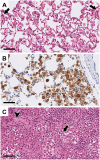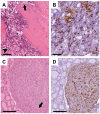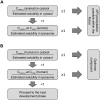Multiorgan Crystal Deposition of an Amphoteric Drug in Rats Due to Lysosomal Accumulation and Conversion to a Poorly Soluble Hydrochloride Salt
- PMID: 33454789
- PMCID: PMC8041455
- DOI: 10.1093/toxsci/kfaa191
Multiorgan Crystal Deposition of an Amphoteric Drug in Rats Due to Lysosomal Accumulation and Conversion to a Poorly Soluble Hydrochloride Salt
Abstract
Poor solubility of drug candidates mainly affects bioavailability, but poor solubility of drugs and metabolites can also lead to precipitation within tissues, particularly when high doses are tested. RO0728617 is an amphoteric compound bearing basic and acidic moieties that has previously demonstrated good solubility at physiological pH but underwent widespread crystal deposition in multiple tissues in rat toxicity studies. The aim of our investigation was to better characterize these findings and their underlying mechanism(s), and to identify possible screening methods in the drug development process. Main microscopic features observed in rat RO0728617 toxicity studies were extensive infiltrates of crystal-containing macrophages in multiple organs. Matrix-assisted laser desorption/ionization Fourier transform ion cyclotron resonance mass spectrometry revealed that these crystals contained the orally administered parent compound, and locality was confirmed to be intracytoplasmic and partly intralysosomal by electron microscopic examination. Crystal formation was explained by lysosomal accumulation of the compound followed by precipitation of the hydrochloride salt under physiological conditions in the lysosomes, which have a lower pH and higher chloride concentration in comparison to the cytosol. This study demonstrates that risk of drug precipitation can be assessed by comparing the estimated lysosomal drug concentration at a given dose with the solubility of the compound at lysosomal conditions.
Keywords: crystal deposition; drug precipitation; lysosomal accumulation; macrophages; organ toxicity.
© The Author(s) 2021. Published by Oxford University Press on behalf of the Society of Toxicology.
Figures










Similar articles
-
An Expandable Mechanopharmaceutical Device (1): Measuring the Cargo Capacity of Macrophages in a Living Organism.Pharm Res. 2018 Nov 12;36(1):12. doi: 10.1007/s11095-018-2539-6. Pharm Res. 2018. PMID: 30421091 Free PMC article.
-
Incorporation of lysosomal sequestration in the mechanistic model for prediction of tissue distribution of basic drugs.Eur J Pharm Sci. 2017 Nov 15;109:419-430. doi: 10.1016/j.ejps.2017.08.014. Epub 2017 Aug 18. Eur J Pharm Sci. 2017. PMID: 28823852
-
Estimating the maximal solubility advantage of drug salts.Int J Pharm. 2021 Feb 15;595:120228. doi: 10.1016/j.ijpharm.2021.120228. Epub 2021 Jan 21. Int J Pharm. 2021. PMID: 33484924
-
In vivo deposition of poorly soluble drugs.Adv Drug Deliv Rev. 2024 Aug;211:115358. doi: 10.1016/j.addr.2024.115358. Epub 2024 Jun 6. Adv Drug Deliv Rev. 2024. PMID: 38851590 Review.
-
Enhancing the solubility and bioavailability of poorly water-soluble drugs using supercritical antisolvent (SAS) process.Int J Pharm. 2018 Mar 1;538(1-2):1-13. doi: 10.1016/j.ijpharm.2017.12.041. Epub 2017 Dec 24. Int J Pharm. 2018. PMID: 29278733 Review.
Cited by
-
Toward Realistic Dosimetry In Vitro: Determining Effective Concentrations of Test Substances in Cell Culture and Their Prediction by an In Silico Mass Balance Model.Chem Res Toxicol. 2022 Nov 21;35(11):1962-1973. doi: 10.1021/acs.chemrestox.2c00128. Epub 2022 Oct 20. Chem Res Toxicol. 2022. PMID: 36264934 Free PMC article.
-
Antidepressants enter cells, organelles, and membranes.Neuropsychopharmacology. 2024 Jan;49(1):246-261. doi: 10.1038/s41386-023-01725-x. Epub 2023 Oct 2. Neuropsychopharmacology. 2024. PMID: 37783840 Free PMC article. Review.
References
-
- A, ziz R., Helms W. (2009). Pharmacology/toxicology review and evaluation: Pazopanib. Available at: https://www.accessdata.fda.gov/drugsatfda_docs/nda/2009/022465s000_Pharm....
-
- Bhatnagar V., Anjaiah S., Puri N., Darshanam B., Ramaiah A. (1993). pH of melanosomes of B 16 murine melanoma is acidic: Its physiological importance in the regulation of melanin biosynthesis. Arch. Biochem. Biophys. 307, 183–192. - PubMed
-
- Boyd B. J., Bergström C. A. S., Vinarov Z., Kuentz M., Brouwers J., Augustijns P., Brandl M., Bernkop-Schnürch A., Shrestha N., Préat V., et al. (2019). Successful oral delivery of poorly water-soluble drugs both depends on the intraluminal behavior of drugs and of appropriate advanced drug delivery systems. Eur. J. Pharm. Sci. 137, 104967. - PubMed
Publication types
MeSH terms
Substances
LinkOut - more resources
Full Text Sources
Other Literature Sources
Medical

